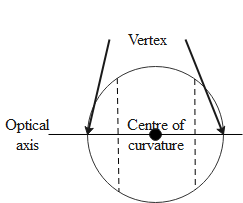
What is the optical axis?
Answer
520.5k+ views
Hint: The question is based on the concept of optics. the optical axis of the spherical mirrors passes through its geometrical centre and its centre of curvature. The spherical mirrors and the lens have this optical axis.
Complete answer:
The straight line joining the pole and the centre of curvature of the spherical mirror extended on both sides is the optical axis.
The optical axis is also called the principal axis. This principal axis is taken as the x-axis. The heights measured upwards and perpendicular to the principal axis are taken as positive and the heights measured downwards and perpendicular to the principal axis are taken as negative.
The diagram representing the optical axis is given as follows.
In the case of a convex lens.

In the case of a concave lens.

In the case of a concave mirror.

In the case of a concave mirror.

The path of the light ray along the principal axis perpendicular to the surfaces will be unchanged.
The diagrammatic representation of the definition of the optical axis, that is, a straight line joining the pole and the centre of curvature of the spherical mirror extended on both sides, is given as follows.

\[\therefore \] The optical axis is a straight line joining the pole and the centre of curvature of the spherical mirror extended on both sides.
Note:
The term optic axis is different from the term optical axis. The optic axis is a term used in crystallography, whereas, the optical axis is a term used in optics. Irrespective of the type of mirror, the optical axis remains the same, similarly, in the case of a lens, irrespective of the type of lens, the optical axis remains the same.
Complete answer:
The straight line joining the pole and the centre of curvature of the spherical mirror extended on both sides is the optical axis.
The optical axis is also called the principal axis. This principal axis is taken as the x-axis. The heights measured upwards and perpendicular to the principal axis are taken as positive and the heights measured downwards and perpendicular to the principal axis are taken as negative.
The diagram representing the optical axis is given as follows.
In the case of a convex lens.

In the case of a concave lens.

In the case of a concave mirror.

In the case of a concave mirror.

The path of the light ray along the principal axis perpendicular to the surfaces will be unchanged.
The diagrammatic representation of the definition of the optical axis, that is, a straight line joining the pole and the centre of curvature of the spherical mirror extended on both sides, is given as follows.

\[\therefore \] The optical axis is a straight line joining the pole and the centre of curvature of the spherical mirror extended on both sides.
Note:
The term optic axis is different from the term optical axis. The optic axis is a term used in crystallography, whereas, the optical axis is a term used in optics. Irrespective of the type of mirror, the optical axis remains the same, similarly, in the case of a lens, irrespective of the type of lens, the optical axis remains the same.
Recently Updated Pages
Master Class 12 Business Studies: Engaging Questions & Answers for Success

Master Class 12 Economics: Engaging Questions & Answers for Success

Master Class 12 English: Engaging Questions & Answers for Success

Master Class 12 Maths: Engaging Questions & Answers for Success

Master Class 12 Social Science: Engaging Questions & Answers for Success

Master Class 12 Chemistry: Engaging Questions & Answers for Success

Trending doubts
What are the major means of transport Explain each class 12 social science CBSE

Which are the Top 10 Largest Countries of the World?

Draw a labelled sketch of the human eye class 12 physics CBSE

How much time does it take to bleed after eating p class 12 biology CBSE

Explain sex determination in humans with line diag class 12 biology CBSE

Differentiate between homogeneous and heterogeneous class 12 chemistry CBSE




